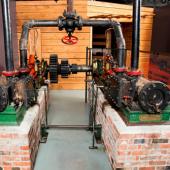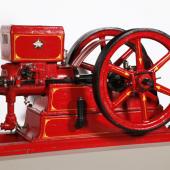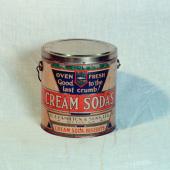
A miner’s hard hat from the early 1900s. For more coal mining artifacts see our Coal & Grit exhibit artifact slideshow.

The Davies steam engine, on display in the Age of Steam Gallery, is really two engines linked together. It was built in Pictou in 1866 and used to haul boats on a marine railway.

This exquisitely detailed model of a wood-burning locomotive can be seen in the Age of Steam. It bears a plaque reading Avon Locomotive Works 1866 and it was on display in Windsor in 1900 where an American visitor bought it. It returned to Nova Scotia in 1971.

Various union agreements. These small booklets were distributed to all union members so that they would have access to information about their rights under the agreement.

This little lapel pin was part of the protest following the Westray mining disaster in Plymouth, N.S. in 1992. The families of the 26 miners killed and their supporters lobbied for improved worker safety legislation. The canary is a symbol related to mine safety and the legend at the bottom reads: “USW Day of Mourning”. Not currently on display

This neon sign hanging in our exhibit shows the New Glasgow, N.S. company’s pride in their work.

One of many railway photos in our collection. This shows Locomotive 42 (which is also an artifact in our collection) at the railway sheds in Stellarton.

The striking cover of a catalogue produced by Acadia Gas Engines of Bridgewater, a leading producer of marine and stationary engines in Nova Scotia. Not currently on display

A ten horse-power, double flywheel stationary engine made by Acadia Gas Engines of Bridgewater.

Albion can be seen in our Visible Storage. Find out more about it in our Locomotives and Conservation sections.
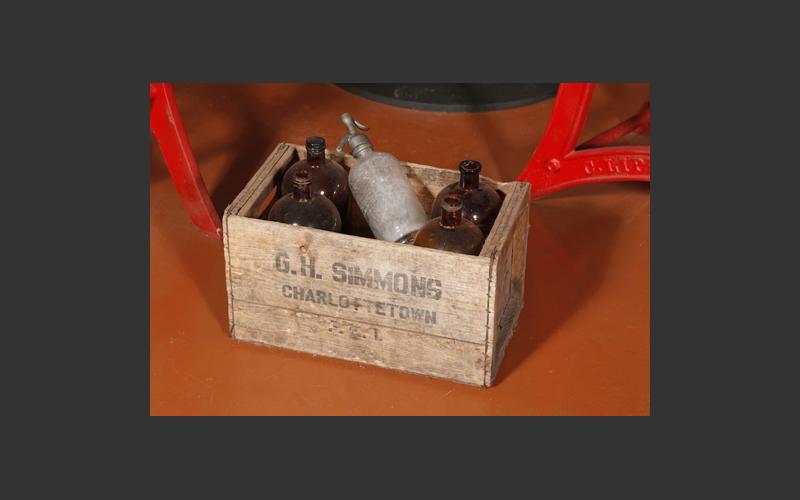
A few siphon bottles from our soda pop display. They were used to dispense carbonated water and could be refilled by a pop bottling plant.

Soft drinks were made in many parts of Nova Scotia in the late 1800s and early 1900s. This tank was part of the equipment for making fizzy drinks under pressure.

Nova Scotia soft drinks bottles. Some are made of pottery and some of glass. A wide range of flavours from ginger beer to orange pulpy was made in small shops across the province.

This large scale camera was used at Sydney Steel to copy large documents like blueprints.

1935 model Electrolux vacuum cleaner made in Canada, possibly at the company’s plant in Amherst, NS. It is part of our exhibit discussing how life changed with the introduction of electricity into the home.

Carding machine for cotton from Dominion Textiles in Yarmouth. Part of the process of changing raw cotton into cloth, the carder uses bristled rollers to align the fibres to make the material ready for spinning.

Conductor’s cap from the Pictou County Electric Co. Ltd. Before there were buses, some power companies operated electric streetcars in several Nova Scotia communities. The conductor collected the passenger’s fares.

An electric refrigerator was one of the improvements electricity brought to home life. This one was purchased by a Cape Breton coal miner from his Co-op store.

A tin for cream soda biscuits, one of 300 kinds made by G.J. Hamilton Bakery, Pictou. This large industrial bakery started in 1840 and by 1900 it was the largest and most modern biscuit factory in the region, shipping biscuits and confectionery as far as the West Indies.

Charter establishing Local 50 of the Mine Workers Union of Canada in Westville June 9, 1928. The coal miners of Westville had become dissatisfied with the representation of the United Mine Workers and sought an alternative.

A pressed glass compote on display with goblets, kerosene lamp shades and plates. Nova Scotia had a short-lived pressed glass industry based in Trenton, N.S.

The industrial knitting machine from a local knitwear factory can be spied in our Visible Storage display.

The Lady Scotia stove was part of a range of handsome enameled wood-burning kitchen stoves made in the 1920s and 1930s by Lunenburg Foundry.

Railway lantern. Lanterns like this were used not only as a light source, but also as a method of signaling at night between railway engineers and the workers in the railyards.

See the “saddle-back” shape of the boiler on our Locomotive Number 5, made by Baldwin Locomotive Works. For more information see the Locomotives section.
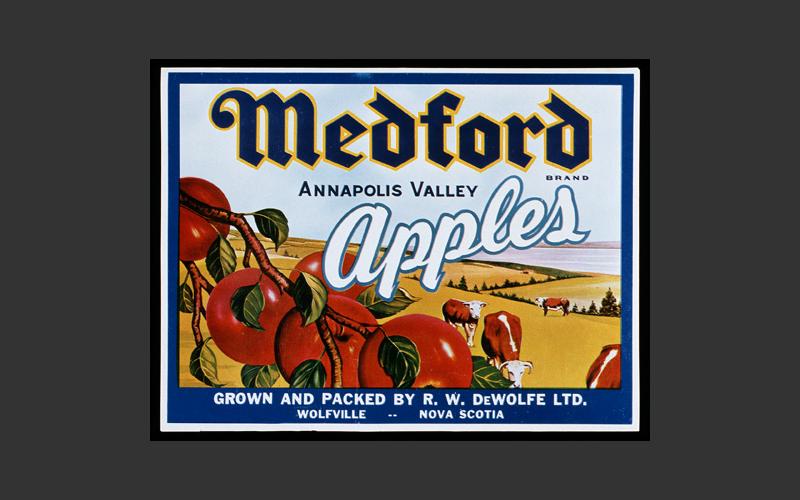
Medford Apples label. The export of apples from the Annapolis Valley is still an important Nova Scotia export. Did you know the Gravenstein apple was developed in Nova Scotia?

Some of us still remember helping our mom by putting sodden clothes through the wringer on washers like this to help remove water before hanging them outside on a clothesline to dry.Even though these electric machines were labour-saving, they seem like a lot of work compared to today!
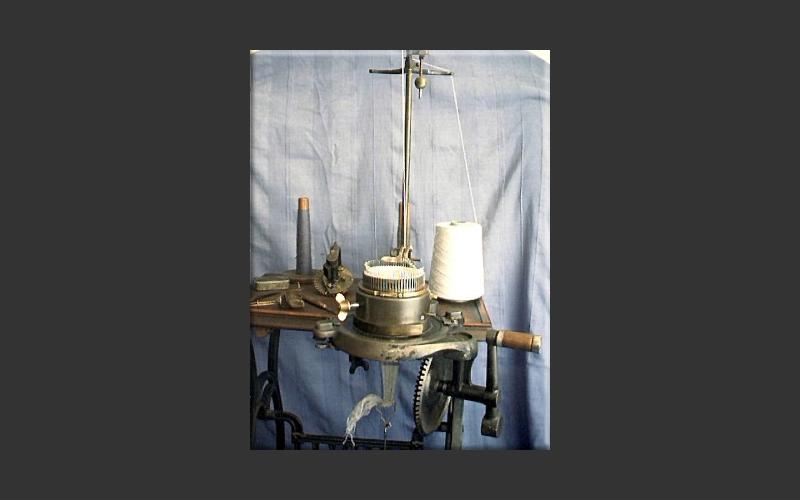
A table-mounted knitting machine for making socks. Built on the same principles as large industrial machines, these small versions were marketed to housewives as a way to make money at home.

“The Ovens” by Joseph Purcell, 1987. One of a group of twelve paintings depicting gold mining areas in Nova Scotia as they would have been in the 1800s when gold fever was at its height in the province.

The shiny artifact on the left in our electricity exhibit is a Kaplin water turbine runner. It was from a hydroelectric power plant at Cowie Falls, Queen’s Co., NS. and represents one of the ways we create electric power.

A Smith Premier No. 10 manual typewriter with full keyboard. The black keys type uppercase and the white keys type lowercase letters. This model was introduced in 1908 and was the primary tool for clerical work. Not currently on display

The typing class. This photo was taken at a Nova Scotia business school in the early 1920s. Note how few male students are in the class. The introduction of the typewriter brought many more women into offices starting in the late 1800s.

The speedometer inside the 1963 Volvo made in Nova Scotia and on display. For more information See Automobiles.

The model of our 1963 Volvo is The “Canadian”. It was Volvo’s first model assembled outside Sweden.

The shoulder seatbelt inside our Volvo. Volvo was the first to introduce this safety innovation, making it standard equipment from 1959 onward.

Although you can’t climb inside, this is how the interior of our 1963 Volvo looks. The restored interior features red leather seats just like the day it rolled off the assembly line.
 A miner’s hard hat from the early 1900s. For more coal mining artifacts see our Coal & Grit exhibit artifact slideshow.
A miner’s hard hat from the early 1900s. For more coal mining artifacts see our Coal & Grit exhibit artifact slideshow. The Davies steam engine, on display in the Age of Steam Gallery, is really two engines linked together. It was built in Pictou in 1866 and used to haul boats on a marine railway.
The Davies steam engine, on display in the Age of Steam Gallery, is really two engines linked together. It was built in Pictou in 1866 and used to haul boats on a marine railway. This exquisitely detailed model of a wood-burning locomotive can be seen in the Age of Steam. It bears a plaque reading Avon Locomotive Works 1866 and it was on display in Windsor in 1900 where an American visitor bought it. It returned to Nova Scotia in 1971.
This exquisitely detailed model of a wood-burning locomotive can be seen in the Age of Steam. It bears a plaque reading Avon Locomotive Works 1866 and it was on display in Windsor in 1900 where an American visitor bought it. It returned to Nova Scotia in 1971. Various union agreements. These small booklets were distributed to all union members so that they would have access to information about their rights under the agreement.
Various union agreements. These small booklets were distributed to all union members so that they would have access to information about their rights under the agreement. This little lapel pin was part of the protest following the Westray mining disaster in Plymouth, N.S. in 1992. The families of the 26 miners killed and their supporters lobbied for improved worker safety legislation. The canary is a symbol related to mine safety and the legend at the bottom reads: “USW Day of Mourning”. Not currently on display
This little lapel pin was part of the protest following the Westray mining disaster in Plymouth, N.S. in 1992. The families of the 26 miners killed and their supporters lobbied for improved worker safety legislation. The canary is a symbol related to mine safety and the legend at the bottom reads: “USW Day of Mourning”. Not currently on display This neon sign hanging in our exhibit shows the New Glasgow, N.S. company’s pride in their work.
This neon sign hanging in our exhibit shows the New Glasgow, N.S. company’s pride in their work. One of many railway photos in our collection. This shows Locomotive 42 (which is also an artifact in our collection) at the railway sheds in Stellarton.
One of many railway photos in our collection. This shows Locomotive 42 (which is also an artifact in our collection) at the railway sheds in Stellarton. The striking cover of a catalogue produced by Acadia Gas Engines of Bridgewater, a leading producer of marine and stationary engines in Nova Scotia. Not currently on display
The striking cover of a catalogue produced by Acadia Gas Engines of Bridgewater, a leading producer of marine and stationary engines in Nova Scotia. Not currently on display A ten horse-power, double flywheel stationary engine made by Acadia Gas Engines of Bridgewater.
A ten horse-power, double flywheel stationary engine made by Acadia Gas Engines of Bridgewater. Albion can be seen in our Visible Storage. Find out more about it in our Locomotives and Conservation sections.
Albion can be seen in our Visible Storage. Find out more about it in our Locomotives and Conservation sections. A few siphon bottles from our soda pop display. They were used to dispense carbonated water and could be refilled by a pop bottling plant.
A few siphon bottles from our soda pop display. They were used to dispense carbonated water and could be refilled by a pop bottling plant. Soft drinks were made in many parts of Nova Scotia in the late 1800s and early 1900s. This tank was part of the equipment for making fizzy drinks under pressure.
Soft drinks were made in many parts of Nova Scotia in the late 1800s and early 1900s. This tank was part of the equipment for making fizzy drinks under pressure. Nova Scotia soft drinks bottles. Some are made of pottery and some of glass. A wide range of flavours from ginger beer to orange pulpy was made in small shops across the province.
Nova Scotia soft drinks bottles. Some are made of pottery and some of glass. A wide range of flavours from ginger beer to orange pulpy was made in small shops across the province. This large scale camera was used at Sydney Steel to copy large documents like blueprints.
This large scale camera was used at Sydney Steel to copy large documents like blueprints. 1935 model Electrolux vacuum cleaner made in Canada, possibly at the company’s plant in Amherst, NS. It is part of our exhibit discussing how life changed with the introduction of electricity into the home.
1935 model Electrolux vacuum cleaner made in Canada, possibly at the company’s plant in Amherst, NS. It is part of our exhibit discussing how life changed with the introduction of electricity into the home. Carding machine for cotton from Dominion Textiles in Yarmouth. Part of the process of changing raw cotton into cloth, the carder uses bristled rollers to align the fibres to make the material ready for spinning.
Carding machine for cotton from Dominion Textiles in Yarmouth. Part of the process of changing raw cotton into cloth, the carder uses bristled rollers to align the fibres to make the material ready for spinning. Conductor’s cap from the Pictou County Electric Co. Ltd. Before there were buses, some power companies operated electric streetcars in several Nova Scotia communities. The conductor collected the passenger’s fares.
Conductor’s cap from the Pictou County Electric Co. Ltd. Before there were buses, some power companies operated electric streetcars in several Nova Scotia communities. The conductor collected the passenger’s fares. An electric refrigerator was one of the improvements electricity brought to home life. This one was purchased by a Cape Breton coal miner from his Co-op store.
An electric refrigerator was one of the improvements electricity brought to home life. This one was purchased by a Cape Breton coal miner from his Co-op store. A tin for cream soda biscuits, one of 300 kinds made by G.J. Hamilton Bakery, Pictou. This large industrial bakery started in 1840 and by 1900 it was the largest and most modern biscuit factory in the region, shipping biscuits and confectionery as far as the West Indies.
A tin for cream soda biscuits, one of 300 kinds made by G.J. Hamilton Bakery, Pictou. This large industrial bakery started in 1840 and by 1900 it was the largest and most modern biscuit factory in the region, shipping biscuits and confectionery as far as the West Indies. Charter establishing Local 50 of the Mine Workers Union of Canada in Westville June 9, 1928. The coal miners of Westville had become dissatisfied with the representation of the United Mine Workers and sought an alternative.
Charter establishing Local 50 of the Mine Workers Union of Canada in Westville June 9, 1928. The coal miners of Westville had become dissatisfied with the representation of the United Mine Workers and sought an alternative. A pressed glass compote on display with goblets, kerosene lamp shades and plates. Nova Scotia had a short-lived pressed glass industry based in Trenton, N.S.
A pressed glass compote on display with goblets, kerosene lamp shades and plates. Nova Scotia had a short-lived pressed glass industry based in Trenton, N.S. The industrial knitting machine from a local knitwear factory can be spied in our Visible Storage display.
The industrial knitting machine from a local knitwear factory can be spied in our Visible Storage display. The Lady Scotia stove was part of a range of handsome enameled wood-burning kitchen stoves made in the 1920s and 1930s by Lunenburg Foundry.
The Lady Scotia stove was part of a range of handsome enameled wood-burning kitchen stoves made in the 1920s and 1930s by Lunenburg Foundry. Railway lantern. Lanterns like this were used not only as a light source, but also as a method of signaling at night between railway engineers and the workers in the railyards.
Railway lantern. Lanterns like this were used not only as a light source, but also as a method of signaling at night between railway engineers and the workers in the railyards. See the “saddle-back” shape of the boiler on our Locomotive Number 5, made by Baldwin Locomotive Works. For more information see the Locomotives section.
See the “saddle-back” shape of the boiler on our Locomotive Number 5, made by Baldwin Locomotive Works. For more information see the Locomotives section. Medford Apples label. The export of apples from the Annapolis Valley is still an important Nova Scotia export. Did you know the Gravenstein apple was developed in Nova Scotia?
Medford Apples label. The export of apples from the Annapolis Valley is still an important Nova Scotia export. Did you know the Gravenstein apple was developed in Nova Scotia? Some of us still remember helping our mom by putting sodden clothes through the wringer on washers like this to help remove water before hanging them outside on a clothesline to dry.Even though these electric machines were labour-saving, they seem like a lot of work compared to today!
Some of us still remember helping our mom by putting sodden clothes through the wringer on washers like this to help remove water before hanging them outside on a clothesline to dry.Even though these electric machines were labour-saving, they seem like a lot of work compared to today! A table-mounted knitting machine for making socks. Built on the same principles as large industrial machines, these small versions were marketed to housewives as a way to make money at home.
A table-mounted knitting machine for making socks. Built on the same principles as large industrial machines, these small versions were marketed to housewives as a way to make money at home. “The Ovens” by Joseph Purcell, 1987. One of a group of twelve paintings depicting gold mining areas in Nova Scotia as they would have been in the 1800s when gold fever was at its height in the province.
“The Ovens” by Joseph Purcell, 1987. One of a group of twelve paintings depicting gold mining areas in Nova Scotia as they would have been in the 1800s when gold fever was at its height in the province. The shiny artifact on the left in our electricity exhibit is a Kaplin water turbine runner. It was from a hydroelectric power plant at Cowie Falls, Queen’s Co., NS. and represents one of the ways we create electric power.
The shiny artifact on the left in our electricity exhibit is a Kaplin water turbine runner. It was from a hydroelectric power plant at Cowie Falls, Queen’s Co., NS. and represents one of the ways we create electric power. A Smith Premier No. 10 manual typewriter with full keyboard. The black keys type uppercase and the white keys type lowercase letters. This model was introduced in 1908 and was the primary tool for clerical work. Not currently on display
A Smith Premier No. 10 manual typewriter with full keyboard. The black keys type uppercase and the white keys type lowercase letters. This model was introduced in 1908 and was the primary tool for clerical work. Not currently on display The typing class. This photo was taken at a Nova Scotia business school in the early 1920s. Note how few male students are in the class. The introduction of the typewriter brought many more women into offices starting in the late 1800s.
The typing class. This photo was taken at a Nova Scotia business school in the early 1920s. Note how few male students are in the class. The introduction of the typewriter brought many more women into offices starting in the late 1800s. The speedometer inside the 1963 Volvo made in Nova Scotia and on display. For more information See Automobiles.
The speedometer inside the 1963 Volvo made in Nova Scotia and on display. For more information See Automobiles. The model of our 1963 Volvo is The “Canadian”. It was Volvo’s first model assembled outside Sweden.
The model of our 1963 Volvo is The “Canadian”. It was Volvo’s first model assembled outside Sweden. The shoulder seatbelt inside our Volvo. Volvo was the first to introduce this safety innovation, making it standard equipment from 1959 onward.
The shoulder seatbelt inside our Volvo. Volvo was the first to introduce this safety innovation, making it standard equipment from 1959 onward. Although you can’t climb inside, this is how the interior of our 1963 Volvo looks. The restored interior features red leather seats just like the day it rolled off the assembly line.
Although you can’t climb inside, this is how the interior of our 1963 Volvo looks. The restored interior features red leather seats just like the day it rolled off the assembly line.
